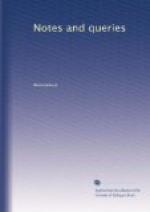SCOTUS.
* * * * *
GRAY’S ELEGY.—DRONING.—DODSLEY’S POEMS.
(Vol. ii., pp. 264. 301.)
I only recur to the subject of Gray’s Elegy to remark, that although your correspondents, A HERMIT AT HAMPSTEAD, and W.S., have given me a good deal of information, for which I thank them, they have not answered either of my Queries.
I never doubted as to the true reading of the third line of the second stanza of Gray’s Elegy, but merely remarked that in one place the penultimate word was printed drony, and other authorities droning. With reference to this point, what I wanted to know was merely, whether, in any good annotated edition of the poem, it had been stated that when Dodsley printed it in his Collection of Poems, 1755, vol. iv., the epithet applied to flight was drony, and not droning? I dare say the point has not escaped notice; but if it have, the fact is just worth observation.
Next, any doubt is not at all cleared up respecting the date of publication of Dodsley’s Collection. The Rev. J. Mitford, in his Aldine edition of Gray, says (p. xxxiii.) that the first three volumes came out in 1752, whereas my copy of “the second edition” bears the date of 1748. Is that the true date, or do editions vary? If the second edition came out in 1748, what was the date of the first edition? I only put this last question because, as most people are aware, some poems of note originally appeared in Dodsley’s Collection of Poems, and it is material to ascertain the real year when they first came from the press.
THE HERMIT OF HOLYPORT.
* * * * *
REPLIES TO MINOR QUERIES.
Zuendnadel Guns (Vol. ii., p. 247.).—JARLTZBERG “would like to know when and by whom they were invented, and their mechanism.”
To describe mechanism without diagrams is both tedious and difficult; but I shall be happy to show JARLTZBRG one of them in my possession, if he will favour me with a call,—for which purpose I inclose my address, to be had at your office. The principle is, to load at the breach, and the cartridge contains the priming, which is ignited by the action of a pin striking against it. It is one of the worst of many methods of loading at the breach; and the same principle was patented in England by A.A. Moser, a German, more than ten years ago. {344}
It has already received the attention of our Ordnance department, and has been tried at Woolwich. The letter to which JARTZBERG refers, dated Berlin, Sept. 11., merely shows the extreme ignorance of the writer on such subjects, as the range he mentions has nothing whatever to do with the principle or mechanism of the gun in question. He ought also, before he expressed himself so strongly, to have known, that the extreme range of an English percussion musket is nearer one mile than 150 yards (which latter distance, he says, they do not exceed) and he would not have been so astonished at the range of the Zuendnadel guns being 800 yards, if he had seen, as I have, a plain English two-grooved rifle range 1200 yards, with a proper elevation for the distance, and a conical projectile instead of a ball.




